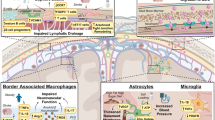Summary
This report describes the relationship between the intensity of early inflammation after acute myocardial infarction and the later thickness of the left ventricular (LV) scar. Histologic sections of hearts from methylprednisolone-treated (MP), cobra venom factor-treated (CVF), and untreated control rats that had been subjected to either 2 or 21 days of coronary artery occlusion were studied. In the rats examined at 2 days (n=20 for MP, n=16 for CVF, and n=20 for controls), a semiquantitative inflammation score (1–4) was attributed to each infarct. Mononuclear (MN) cells were counted in 4 oil-immersion fields per section and polymorphonuclear (PMN) cells in 9 oil-immersion fields per section. In the rats examined at 21 days (n=22 for MP, n=22 for CVF, and n=26 for controls), the thickness of the LV scar was measured every 1.6 mm along its circumference. Inflammation scores at 2 days were 3.5±.6 for controls, 1.5±.5 for MP, and 2.9±.8 for CVF (p<.05 among groups). The MN cells counted were 73±7 for controls, 47±5 for MP, and 61±9 for CVF (p<.05 among groups). There was no difference in PMN infiltrate among groups. Scar thickness at 21 days were .9±.1 mm for controls, .7±.1 mm for MP, and .9±.1 mm for CVF (MP compared to CVF and controls, p<.01).
Thus, a severe reduction in early MN cell infiltration was associated later with thinner LV scars, while a moderate reduction did not alter scar formation. Furthermore, though MN cell infiltration was suppressed by MP and CVF, PMN cell infiltration was unaffected.
Similar content being viewed by others
References
Bulkley BA, Roberts WC (1974) Steroid therapy during acute myocardial infarction. A cause of delayed healing of ventricular aneurysm. Am J Med 56:244–250
Cochrane CG, Muller-Eberhard HJ, Aikin BS (1970) Depletion of plasma complement in vivo by a protein of cobra venom. Its effects on various immunologic reactions. J Immunol 105:55–69
Cohnheim J (1889) Lectures in General Pathology. Translated by McKee AD from the 2nd German edition, Vol I and II. New Sydenham Society, London
Dannenberg AM (1979) The antiinflammatory effects of glycorticosteroids. Inflammation 3:329–343
Fauci AS, Dale DC, Balow JE (1976) Glucocorticosteroid therapy: mechanisms of action and clinical consideration. Ann Intern Med 84:304–315
Fearon DT, Ruddy S, Knostman JD, Carpenter CB, Austen KF (1974) The functional significance of complement. Adv Nephrology 4:15–35
Fernandez HN, Henson PM, Otani A, Hugli TE (1978) Chemotactic response to human C3a and C5a anaphylatoxins. I. Evaluation of C3a and C5a leukotaxis in vitro and under simulated in vivo conditions. J Immunol 120:109–115
Flynn PJ, Becker WK, Hammerschmidt DE, Craddock PR, Weisdorf P, Lillehei RC, Jacob HS (1980) Myocardial infarct (MI) size is reduced by inhibition of granulocyte (PMN), not platelet aggregation. (Abstr) Clin Res 28:169A
Gotze O, Muller-Eberhard HJ (1971) The C3 activator system: an alternative pathway of complement activation. J Exp Med 134:90–108
Hammerman H, Kloner RA, Hale S, Schoen FJ, Braunwald E (1983) Dose dependent effects of short term methylprednisolone on myocardial infarct extent, scar formation and ventricular function. Circulation 68:446–452
Hepper NGG, Ruitt R, Donald DE, Edwards J (1955) The effect of cortisone on experimentally produced myocardial infarcts. Circulation 11:742–748
Hill JH, Ward PA (1971) The philogistic role of C3 leukotactic fragments in myocardial infarcts of rats. J Exp Med 133:885–900
Kloner RA, Fishbein MC, Lew H, Maroko PR, Braunwald E (1978) Mummification of the infarcted myocardium by high dose corticosteroids. Circulation 57:56–63
Maclean D, Fishbein MC, Braunwald E, Maroko PR (1978) Long-term preservation of ischemic myocardium after experimental coronary artery occlusion. J Clin Invest 61:541–551
Maroko PR, Carpenter CB, Chiariello M, Fishbein MC, Radnany P, Knostman JD, Hale SL (1978) Reduction by cobra venom factor of myocardial necrosis after coronary artery occlusion. J Clin Invest 61:661–670
McManus LM, Kolb WP, Crawford MH, O'Rourke RA, Grover FL, Pinckard RN (1983) Complement localization in ischemic baboon myocardium. Lab Invest 48:436–447
Muller-Eberhard HJ, Fjellstrom KE (1971) Isolation of the anticomplementary protein from cobra venom and its mode of action and C3. J Immunol 107:1666–1672
Pinckard RN, Olson MS, Gielas PC, Terry R, Boyer JT, O'Rourke RA (1975) Consumption of classical complement components by heart subcellular membranes in vitro and in patients after acute myocardial infarction. J Clin Invest 56:740–750
Pinckard RN, O'Rourke RA, Crawford MH, Grover FS, McManus LM, Ghidoni JJ, Storrs SB, Olson MS (1980) Complement localization and mediation of ischemic injury in baboon myocardium. J Clin Invest 66:1050–1056
Roberts CS, Maclean D, Braunwald E, Maroko PR, Kloner RA (1983) Topographic changes in the left ventricle after experimentally induced myocardial infarction in the rat. Am J Cardiol 51:872–876
Ruddy S, Gigli I, Austein KF (1972) The complement system of man. N Engl J Med 287:489–495, 545–549, 592–596, 642–646
Ward PA (1971) Complement-derived leukotactic factors in pathological fluids. J Exp Med 134:109–113
Wiener SL, Wiener R, Urivetzky M, Shafer S, Isenberg HD, Calvin J, Meilman E (1975) The mechanism of action of a single dose of methylprednisolone on acute inflammation in vivo. J Clin Invest 56:679–689
Author information
Authors and Affiliations
Additional information
Supported in part by Grants HL-28048 and SCOR HL-26215 from the National Heart, Lung and Blood Institute, NIH, Bethesda, Maryland
This work was done during the tenure of an Established Investigatorship from the American Heart Association and with funds contributed in part by the Massachusetts Heart Association
Rights and permissions
About this article
Cite this article
Roberts, C.S., Maclean, D., Maroko, P. et al. Relation of early mononuclear and polymorphonuclear cell infiltration to late scar thickness after experimentally induced myocardial infarction in the rat. Basic Res Cardiol 80, 202–209 (1985). https://doi.org/10.1007/BF01910468
Received:
Issue Date:
DOI: https://doi.org/10.1007/BF01910468




